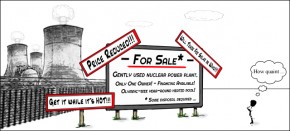In June, 2008, Justice Antonin Scalia delivered the opinion of the Supreme Court regarding its decision in DISTRICT OF COLUMBIA, ET AL., PETITIONERS v.DICK ANTHONY HELLER.
As is my habit, I shall weigh in.
In December, 1791, Congress adopted the Bill of Rights, (i.e. the first 10 amendments to the Constitution.) The second of those amendments states:
A well regulated Militia, being necessary to the security of a free State, the right of the people to keep and bear Arms, shall not be infringed.
After quoting the amendment, Justice Scalia continues . . .
In interpreting this text, we are guided by the principle that . . . the Constitution was written to be understood by the voters; its words and phrases were used in their normal and ordinary as distinguished from technical meaning . . . Normal meaning may of course include an idiomatic meaning, but it excludes secret or technical meanings that would not have been known to ordinary citizens in the founding generation.
I couldn’t agree more. Scalia hits it smack dab on the head. (If one wished to be crude, one could say “Dead Nuts On”, but only if one wished to be crude.) The Constitution was written to be comprehended by the people who lived in the country at the time the Constitution was written. It should go without saying, subsequent populations, with their attendant knowledge of history, would be included in that understanding.
He also goes on to address the two parts of the Second Amendment, that is, the context, (prefatory clause),
A well regulated Militia, being necessary to the security of a free State”, and then the actual point or object of the Amendment itself, (operative clause), “ … the right of the people to keep and bear Arms, shall not be infringed.
I’ll attempt to be brief. (It could happen!)
1. A well regulated militia is necessary to the security of a free state. Righto! Notice the amendment doesn’t simply say, Any ol’ militia will be sufficient to ensure the security of a free state? No, it specifically states, A well regulated militia. There’s a reason for that. You see, regulated comes from the Latin, regula, which means beating the absolute b’jeezus out of anyone who doesn’t follow the rules. (That’s a rough translation, but I’m sure you get the idea.) Anyway, shortly before the Second Amendment was written, that well regulated militia — militias, actually, since each of the 13 colonies had their own — serving alongside the newly formed Continental Army, (and under the command of George Washington), eventually kicked the living shit out of the world’s best trained, best equipped and most experienced standing army.
If you happen to be a free state, that’s how you spell security. The militias and the Continental Army were finally and formally disbanded by Congress in January, 1784. But, as Scalia rightly notes, the people who first lived under the Second Amendment understood that the well regulated militia referenced in the amendment would be “regulated” by . . . wait for it . . . the recently established United States Army. (June, 1784.) Don’t lose track of that. If you include the Continental Army, which was established by the First Continental Congress in June, 1775, the American Army had been in existence for over 16 years by the time the Second Amendment came into being. That’s very important to remember when considering all this stuff. The Bill of Rights was written by and for the people who had just experienced the American Revolution. Some of them had actually served in a well regulated militia. They understood what that term meant. That militia was regulated, ultimately, by and under General George Washington, the Commander in Chief of the Continental Army, who served under, and by authority of, the First Continental Congress.
In other words, the Second Amendment does NOT refer to a rag-tag bunch of weaponized dirt bags out to protect themselves from the guv’mint. Nor does it have anything to do with hunting. Absolutely nothing. At the time . . . 1791 . . . America had a very small army, (Remember, Congress authorized and built one in June, 1775, and then again in June, 1784, to be the trained, fully ready nucleus of a national force), and America wanted it that way. The people living at that time, 1791, understood that if the country was again threatened, the people would be needed to grab their arms, gather together in a militia, join up once more with the well-trained, congressionally approved, standing army, and have their collective, untrained asses trained and regulated by the authorized, national army. Regulated. That’s what American citizens understood in 1791. That’s why any ol’ militia wasn’t part of the Second Amendment. It was, “A well regulated militia”. Just like we did before, in 1775. Every adult American in 1791 knew that.
2. What did “arms” mean to the average citizen in 1791? First, rest assured the Second Amendment did not refer to the massive weaponry carried aboard a ship of the line or an American super-frigate. Neither did the amendment extend to the cannons or mortars found in an artillery regiment. No, according to Congress in 1791, “the people” apparently did NOT have a right to surround themselves with weapons of enormous destructive power, because Congress never addressed such a notion. Those weapons had their rightful place in a congressionally approved military, but the Second Amendment had nothing to do with that. Instead, it was phrased in a way so that the average American living in 1791 would understand that he or she had a right to keep and bear a certain kind or class of weapon. My oldest son, who knows much more about this than I, may correct me, but to the best of my knowledge, the state of the art weapon (i.e. “arm”) in 1791 was a rifled barrel, black powder, single shot rifle.
The citizen of 1791 understood what Congress meant. (Thank you, Justice Scalia.) They, the citizens, would not be prohibited by their government from keeping and bearing their single shot, black powder rifles and pistols. (Their personal weapons.) Why would they not be prohibited from that right? Because those single shot, black powder rifles and pistols might be needed by the citizenry when all those citizens form into militias and join up with the standing army in order to protect the country from an invading force. Remember, in 1791, a well regulated militia is necessary to the security of a free state, because in 1791, in America, the congressionally authorized, standing army was too small (by design) to repel a seriously trained and equipped, invading army. Look, our fellow citizens in those days knew their recent history and they knew what worked. They also knew a very large, standing army, (in the wrong hands), was dangerous to their freedom and extremely expensive to maintain. So they applied a bit of Occam’s Razor, and created a simple compromise: Build a small, full-time army, then reinforce it just like they did in 1775, with a well regulated militia of folks carrying their own, single shot, black powder rifles and pistols.
Let me repeat Antonin Scalia’s own words:
In interpreting this text, we are guided by the principle that . . . the Constitution was written to be understood by the voters; its words and phrases were used in their normal and ordinary as distinguished from technical meaning . . . Normal meaning may of course include an idiomatic meaning, but it excludes secret or technical meanings that would not have been known to ordinary citizens in the founding generation.
In 1791, the Second Amendment could only be understood, as Justice Scalia rightly insists, by the average American citizen, within the context of his or her own life and recent history. That life and recent history included citizens being part of militias that were supplements to a standing army that had been authorized by the very first congress. They, the citizens, were regulated while they were in those militias . . . regulated . . . by rules and orders given, ultimately, by General George Washington. Those rules and orders (i.e. regulations) were sometimes quite severe. (They sometimes even included ordering a firing squad to execute a soldier or militiaman who chafed at the notion of being regulated.) In 1791, every American over the age of 25 understood what a well regulated militia meant. It meant being a part of an army, ready to fight and die for the security of their free state, the United States.
In 1791, being a member of a well regulated militia meant being part of, and being regulated by, the army. There is no other possible understanding an American citizen in 1791 would have. They had just lived through that experience, and they knew it well.
In 1791, “arms” (i.e. personal firearms), meant single shot, black powder muskets, rifles and pistols; the Second Amendment refers ONLY to their use by the citizenry as they are members of well regulated militias; as part of the (regulating) army, to ensure the security of their free state against an invading force. The amendment says nothing about hunting, self protection or even the so-called right to “own” weapons. It is quite tenable to consider the keep and bear phrase as nothing more than a citizen’s obligation to “hold on to” arms temporarily on loan from, (and owned by), the regulated militia. The prefatory and operative clauses make both the context and object clear; this amendment is about the right of American citizens to have within their reach, a weapon or weapons for use by that citizen pursuant to their duties and obligations within a regulated militia.
The prefatory clause is used to demarcate the operative clause, and the amendment’s precise wording addressed an audience that had very recently experienced events that were germane and commonly shared. This was an audience that was glad to be done with war, but was ready, if needed, to take up arms again to defend their young nation against an invading army.
That is what the Second Amendment addressed, and that is what an American in 1791 would have understood.
One might say America has changed a bit since then, yes? Our military is a tad bit larger and more capable. And we have a new militia now; it’s called the Army/Navy/Air Force Reserve. I think every colony . . . oops . . . state, has one. That’s where citizens go when they want to be part of a well regulated militia that teams up with the regular military to keep our free state secure.
Weapons have changed a bit, too, yes? Somehow ordinary citizens have gotten their mitts on weapons that belong firmly and exclusively in the military. How did that happen?
If one insists upon interpreting the Second Amendment contextually, which is, to my way of thinking a good idea, then perhaps one is forced to consider the possibility that, in light of all the things that have changed since it was written, the Second Amendment is well beyond its shelf date.
Thank you, Justice Scalia.






